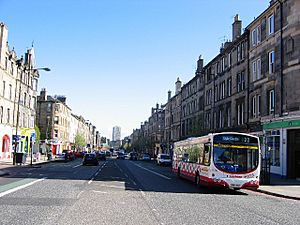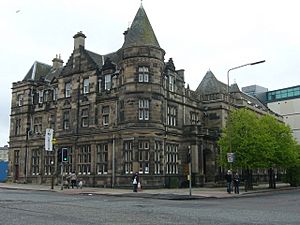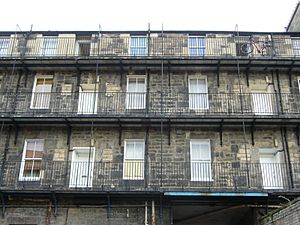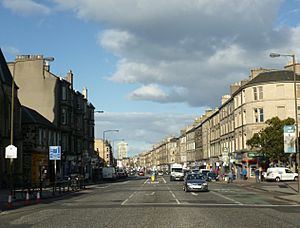Leith Walk facts for kids
Leith Walk is one of the longest streets in Edinburgh, Scotland. It is the main road that connects the city centre to Leith. This street is mostly part of the A900 road. It gently slopes downwards from Picardy Place at one end to the 'Foot of the Walk' at the other. At the 'Foot of the Walk', several other streets meet, including Great Junction Street, Duke Street, Constitution Street, and the Kirkgate.
Even though people usually call the whole street Leith Walk, its upper part actually has different names for different sections. Some parts even have different names on opposite sides of the street! Starting from the upper (south-west) end, the sections on the west side are Picardy Place, Union Place, Antigua Street, Gayfield Place, and Haddington Place. On the east side, you'll find Greenside Place, Baxter's Place, Elm Row, and Brunswick Place. After these, the street continues on both sides as Croall Place, Albert Place, Crighton Place, and finally, after the junction with Pilrig Street, it becomes Leith Walk.
Contents
The Story of Leith Walk
A rough path existed near where Leith Walk is today back in the mid-1400s. This was during the time of James II of Scotland.
The street we know as Leith Walk began as a defensive wall built in 1650. This wall stretched between Calton Hill and Leith. It was meant to protect Edinburgh from Oliver Cromwell's army. The Scots, led by Sir David Leslie, 1st Lord Newark, used this line to stop the attack.
In the early 1700s, coaches started running between Edinburgh and Leith. The first affordable coach service began in 1722. It carried six passengers and cost a small amount of money. At first, only coaches could use the road. Horses and riders were not allowed on certain parts.
Daniel Defoe, a writer, described the path in 1725. He said it was a "handsome Gravel-walk" that was 20 feet wide. It was kept in good condition, and no horses were allowed on it.
Most people walked on this path, which is why it became known as "the Walk." Locals still call it that today. It offered a shorter way to Edinburgh compared to the older Easter Road. However, it didn't become the main road until after the North Bridge was built. The North Bridge was finished in 1772. After 1769, both carriages and horses with riders were allowed on Leith Walk.
By 1763, Leith Walk was already a coach route. A regular service ran from Leith to Edinburgh every hour. The journey took about an hour each way. There was a stop called the Halfway House at Shrubhill. In 1779, a historian named Hugo Arnot noted that 156 coaches used the route daily. Each coach carried four passengers. The road became quite busy and needed repairs. It was rebuilt in 1810 as a "splendid causeway." This raised the road level by about 6 feet.
In 1985, Leith Walk was redesigned. It had an avenue of trees down the middle. Sadly, most of these trees were removed during the tram project. Only a few trees on nearby streets remain.
On April 7, 2023, new tram lines were completed on Leith Walk. The trams now connect Leith to the City Centre and Edinburgh Airport. They are currently being tested for public use.
Buildings Along the Walk
Before the 1870s, Leith Walk was mostly countryside. It had many plant nurseries. There were also separate mansion houses, especially on the west side. When new apartment buildings (tenements) were built, it was easier to buy the mansions on the east side. This is why the two sides of the street still look a bit different. Many tenements were built quickly between Smiths Place and Brunswick Street. These buildings were designed by John Chesser (architect).
The McDonald Road Library is one of the most beautiful buildings on Leith Walk. It was originally a Nelson Hall, funded by the publisher Thomas Nelson. Today, it is a public library run by the City of Edinburgh Council. It was built in 1902 in a style called Baronial Renaissance.
Some famous buildings have disappeared over the last 50 years. The Alhambra Cinema, which was once a theatre, was replaced by a tyre shop. Now, only a pub across the street keeps its name alive. The Halfway House was an old coaching inn from the 1600s. It was later a pub and was taken down in 1983.
The Gardener's Cottage at Haddington Place was built in 1765. It used to serve the first Edinburgh Botanic Garden. It was moved in 2009 and rebuilt in the current Botanic Garden in Inverleith.
The main building of Leith Central Station is still at the Foot of the Walk. The huge railway shed was removed in the 1980s. However, the building that held the station's bars and waiting rooms remains. This includes the Central Bar, which is famous for its more than 250,000 Staffordshire Potteries tiles. These tiles include four large pictures showing sports like golf.
The Bier Hoose bar used to be called The Boundary Bar. It stands on the old border between Leith and Edinburgh. Before Leith and Edinburgh joined in 1920, the bar had two entrances. This was because Leith and Edinburgh had different rules for how late bars could stay open. Customers could move from the Leith side to the Edinburgh side to drink longer!
Pilrig Church (now Pilrig St Paul's Church) can be seen from almost anywhere on Leith Walk. It was built between 1861 and 1863. It has beautiful stained glass windows and an old organ.
On the upper Elm Row section, you can see what remains of the William Williams' New Veterinary College. Only the front building is left. The stables and other buildings were taken down in 2014 to build student housing. The front building was designed in 1872.
Other recent changes include the "Craig and Rose" paint factory. This factory was famous for making the red paint used on the Forth Bridge. This site has now been turned into housing. Leith Walk ends at the Omni Centre and St. James Centre at its southern end. The northern end finishes where Great Junction and Duke streets meet.
Trams on Leith Walk
Leith Walk has a long history with trams. Leith had Scotland's first electric tram in 1905. On Leith Walk, this tram stopped at Pilrig Church. Passengers then had to switch to Edinburgh's cable-drawn trams. This confusing changeover was known as the "Pilrig muddle." Edinburgh didn't switch to electric trams until 1925.
Edinburgh's "last tram" of that era ran in 1956. It ended its journey at the Shrub Hill tram depot on Leith Walk. Trams were stopped because people thought buses were more flexible.
Leith Walk was planned to be part of the new Edinburgh Trams route. This route was supposed to open in 2011. However, this part of the line was cancelled in 2011 due to big delays and high costs. In 2019, the plan to extend the tram line to Leith was approved again. The new tram line officially opened on June 7, 2023.
Shrubhill Area
Shrubhill is a special area on Leith Walk, just south of Pilrig. It was once a place where public punishments took place. This area was known as the Gallow Lee.
Shrubhill House was a large mansion from the 1600s. It was home to Jane Gordon, Duchess of Gordon and her parents. This mansion was taken down around 1960. A concrete building replaced it, which was also taken down in 2015.
From 1905 to 1956, Shrubhill had a big tram depot. Some of these buildings still stand on Dryden Street. The area was redeveloped between 2019 and 2021. It is now mostly homes, with many buildings for student accommodation.
Famous Residents
Many interesting people have lived on or near Leith Walk:
- Grace Cadell (1855-1918) was Scotland's first female surgeon. She ran a safe house for women fighting for the right to vote (suffragettes) at 145 Leith Walk.
- George Coull (1862-1936) was a Scottish chemist who lived in a main house on Smiths Place.
- John Crabbie, who started the famous Crabbie's whisky and ginger drink company, lived at 4 Smiths Place.
- Mary Fee is a Scottish Labour politician.
- F. A. Fitzbayne (1878-1935), who created Leith's electric tram in 1906, lived at 5 Smiths Place.
- Alexander Henderson of Press (died 1826) was the Lord Provost of Edinburgh from 1823 to 1825. He lived in a mansion where Haddington Place is now. A Lord Provost is like a mayor of a city.
- William Allan of Glen (1788-1868) was Lord Provost of Edinburgh from 1829 to 1831. He lived at Hillside House, which was later demolished to build Elm Row.
- The McCulloch of Ardwell family lived in Springfield House, which gave its name to Springfield Street.
- John Smart RSA, a landscape artist, lived at 13 Annandale Street.
Street Name Changes
Some streets near Leith Walk have had their names changed. Iona Street was originally called Falshaw Street, named after Lord Provost James Falshaw. Dalmeny Street was once Colston Street. These names only lasted for about 10 years, from 1880 to 1890.
Leith Walk in Films
- The 1948 documentary film "Waverley Steps" shows old footage of trams on Leith Walk at the Pilrig junction.
See also






